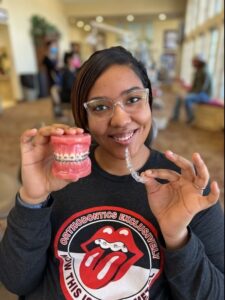Everyone’s oral health journey is unique, but it can be incredibly frustrating when your original treatment requires a tune-up. Luckily, Dr. Shannon and Dr. Revels understand and know just how to get you back on track. When we find ourselves in a position to retrace our steps, it can feel like running in circles. This is likely what adults feel when finding out they may have to retreat their teeth. If you’ve had orthodontic treatment in the past, you may believe your newly straightened smile is set for life. Later on, you may find those orthodontic corrections backsliding and your teeth shifting back into their old positions.
There’s good news, though, the second time around is rarely as long or different as the first. You can even find that your second treatment is more impactful and sets you up for a bright future with an even more radiant smile.
Our team at Orthodontics Exclusively wants to explain some of the benefits of undergoing a second treatment. To help you make the best decisions for your smile, let’s look over some of the options adults have for retreatment.
Retaining your smile
Oh no! Looks like your teeth are shifting. This can be an alarming realization for many former braces patients. While not ideal, shifting is entirely natural. Our teeth can drift back to their original positions over time, even with orthodontic treatment. Movement can also occur when:
- A patient had braces and forgot to wear their retainer.
- Teeth grinding, or bruxism – is any involuntary grinding or clenching of the teeth outside normal chewing, swallowing, or speaking movements. These movements place a strain on the teeth that can alter your bite and sometimes cause misalignment.
- Tooth loss – teeth will naturally shift in the available space left behind.

The tendency of the teeth to return to their original positions is called an orthodontic relapse. Short-term relapse happens less than one year after the completion of treatment. Long-term relapse occurs more than a year after finishing treatment.
Orthodontic relapse is a fairly common occurrence. Some studies estimate that more than 50% of patients will experience some level of relapse within ten years of finishing their treatment. This chance for relapse is one reason orthodontists recommend wearing your retainer regularly.
Clear aligners
Clear aligners are a series of invisible trays that help straighten (“align”) your teeth. They are typically removable and are designed to fit comfortably on your teeth as they work to enhance your smile.
Clear aligners are a great option for patients who had braces when they were younger and just need a touch-up. They also work well for patients who have mild to moderate dental problems. While clear aligners are a great alternative to braces, there are a few things to note when using aligners to ensure the most effective treatment possible.
- Don’t get them dirty. Clear aligners are sensitive and easy to stain, so make sure you drink water exclusively while they’re in. It’s best to remove the aligners when possible while eating or drinking to avoid damage.
- Don’t scratch them. Help your aligners last longer during treatment by taking good care of them.
- Be patient. Sometimes the process of using aligners can seem tedious. It’s important to continue to take good care of your aligners and not rush the process to a beautiful smile.
- Keep them safe. As clear aligners are removable, it’s important to always keep up with where you put them. They are essential in the progression towards a brighter smile.
Clear aligners don’t require any metal, making them easy to apply and use during treatment. As you progress in the teeth-straightening process, the aligners will slowly shift your teeth into place. Each tray is made to slightly shift your teeth until they are perfectly aligned into a new and improved smile.
Clear braces
Like metal braces, clear braces use brackets and wires to help straighten teeth. They are made of ceramic material and are also set with brackets. Clear braces are a popular choice for those who want to blend in during treatment.
The main benefit of getting clear braces is that they are easy to disguise. With the slightly smaller frame, clear braces are designed to blend in with your teeth for a more natural look.
However, it’s important to note that clear braces are more fragile than traditional metal braces. They can also discolor from things like juice or coffee between visits, so it’s important to be careful when choosing clear braces for treatment.

Metal braces
The next option for retreatment is traditional metal braces. They are bridged together using metal brackets and arches to help straighten your teeth over time. They are typically made of stainless steel and nickel, which makes the brackets very durable.
They’re an effective option for treating a wide range of orthodontic issues and can close gaps. And align the teeth relatively quickly. Remember, the treatment and care of your braces are essential. It is important to follow your orthodontist’s instructions to minimize your second treatment’s timeline. Your diet, hygiene routine, and maintaining regular check-ins all factor in the effectiveness of this second treatment. While braces may seem inconvenient, once the treatment is over, your new smile will be all the reward you need.
Rediscover your smile with Orthodontics Exclusively
Here at Orthodontics Exclusively, we want to help you regain your smile. Our team of professionals has many years of experience creating beautiful smiles for patients of all ages in Norman, Oklahoma City, and the surrounding areas. If you are someone you know is considering orthodontic treatment, give us a call. We would love to get you started with a free consultation.
